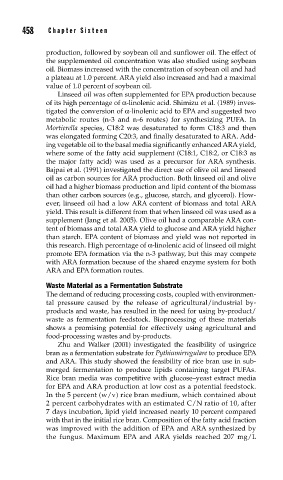Page 486 - Biosystems Engineering
P. 486
458 Cha pte r S i x tee n
production, followed by soybean oil and sunflower oil. The effect of
the supplemented oil concentration was also studied using soybean
oil. Biomass increased with the concentration of soybean oil and had
a plateau at 1.0 percent. ARA yield also increased and had a maximal
value of 1.0 percent of soybean oil.
Linseed oil was often supplemented for EPA production because
of its high percentage of α-linolenic acid. Shimizu et al. (1989) inves-
tigated the conversion of α-linolenic acid to EPA and suggested two
metabolic routes (n-3 and n-6 routes) for synthesizing PUFA. In
Mortierella species, C18:2 was desaturated to form C18:3 and then
was elongated forming C20:3, and finally desaturated to ARA. Add-
ing vegetable oil to the basal media significantly enhanced ARA yield,
where some of the fatty acid supplement (C18:1, C18:2, or C18:3 as
the major fatty acid) was used as a precursor for ARA synthesis.
Bajpai et al. (1991) investigated the direct use of olive oil and linseed
oil as carbon sources for ARA production. Both linseed oil and olive
oil had a higher biomass production and lipid content of the biomass
than other carbon sources (e.g., glucose, starch, and glycerol). How-
ever, linseed oil had a low ARA content of biomass and total ARA
yield. This result is different from that when linseed oil was used as a
supplement (Jang et al. 2005). Olive oil had a comparable ARA con-
tent of biomass and total ARA yield to glucose and ARA yield higher
than starch. EPA content of biomass and yield was not reported in
this research. High percentage of α-linolenic acid of linseed oil might
promote EPA formation via the n-3 pathway, but this may compete
with ARA formation because of the shared enzyme system for both
ARA and EPA formation routes.
Waste Material as a Fermentation Substrate
The demand of reducing processing costs, coupled with environmen-
tal pressure caused by the release of agricultural/industrial by-
products and waste, has resulted in the need for using by-product/
waste as fermentation feedstock. Bioprocessing of these materials
shows a promising potential for effectively using agricultural and
food-processing wastes and by-products.
Zhu and Walker (2001) investigated the feasibility of usingrice
bran as a fermentation substrate for Pythiumirregulare to produce EPA
and ARA. This study showed the feasibility of rice bran use in sub-
merged fermentation to produce lipids containing target PUFAs.
Rice bran media was competitive with glucose–yeast extract media
for EPA and ARA production at low cost as a potential feedstock.
In the 5 percent (w/v) rice bran medium, which contained about
2 percent carbohydrates with an estimated C/N ratio of 10, after
7 days incubation, lipid yield increased nearly 10 percent compared
with that in the initial rice bran. Composition of the fatty acid fraction
was improved with the addition of EPA and ARA synthesized by
the fungus. Maximum EPA and ARA yields reached 207 mg/L

